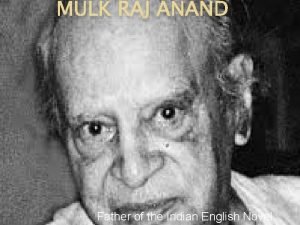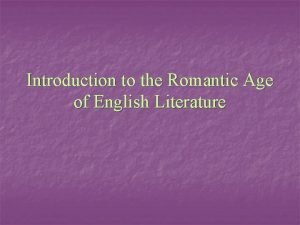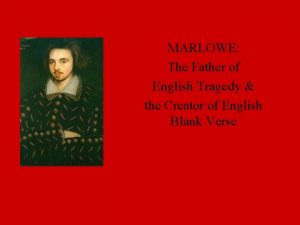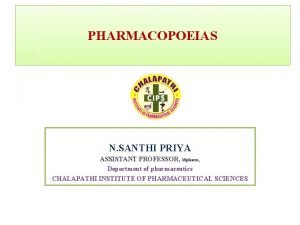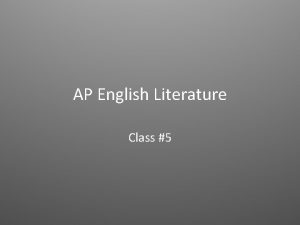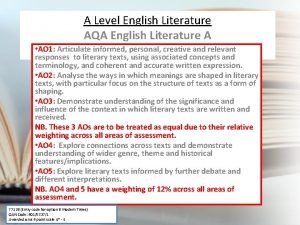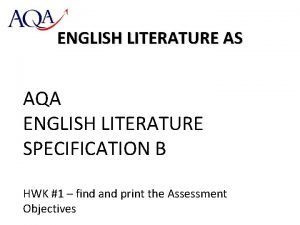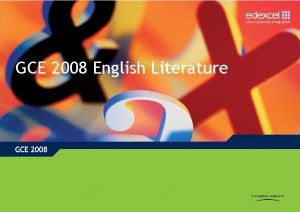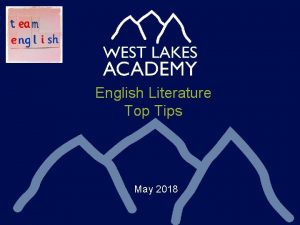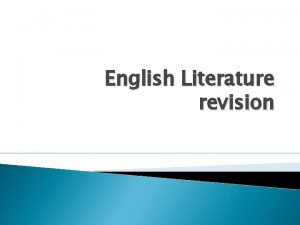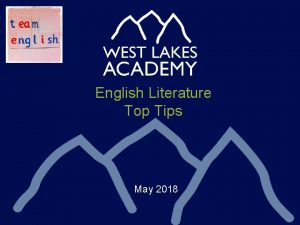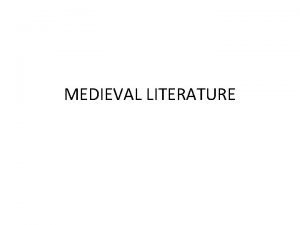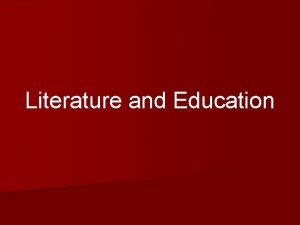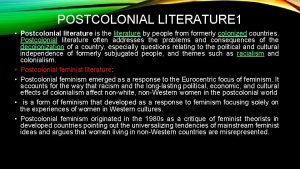INDIAN ENGLISH LITERATURE 1 THE HISTORY OF INDIAN















































- Slides: 47

INDIAN ENGLISH LITERATURE 1. THE HISTORY OF INDIAN LITERATURE. 2. SALMAN RUSHDIE “MIDNIGHT’S CHILDREN” 3. EXPERIMENTAL FORMS IN INDIAN ENGLISH LITERATURE: VISHWAJYOTI GHOSH “DELHI CALM”

Indian English Literature refers to the body of works by authors in India who write in English and whose native or co-native language could be one of the numerous languages of India. It is also associated with the works of members of the Indian diaspora. Many of these writers neither live in India, nor are Indian citizens. As a category, this production comes under the broader realm of postcolonial literature – the production from previously colonized countries such as India. Though one can trace such writers in India to a century back, Indian writing in English has come into force only in the last couple of decades or so, as far as literature goes.

Indian Literature • One of the world’s oldest and richest • Oral traditions – storytellers present traditional Indian text • Literature is influenced by: – A religious doctrine of karma – the chain of good and bad action and their inevitable consequences, which result in the repeated birth and death of the soul. – Mythology of the dominant Hindu deities

Sanskrit Literature Classical Literature Medieval Literature: The Rise Of The Regional Languages Colonial Period To Independence Onwards

SANSKRIT LITERATURE • Literature is written in Sanskrit language • Text were produced about 16 th century BC by people known as Aryans (were cattle herders originally nomadic) who established kingdoms in north India

Religious Text

Ø Composed in Old Sanskrit by Aryan poets Ø Constitute the fundamental scripture of the Hindu religion and used as sacramental rites of Hinduism Ø Compilation of two major literary forms: – Hymns of praise to nature deities – Ritual chants to accompany Aryan religious rituals VEDAS “Book of Knowledge”

The Four VEDAS • Rig-Veda – anthology of 1080 hymns to various gods • ex. “Creation Hymn” * Sama-Veda – “Book of Chants” consists of liturgies. * Yajur-Veda – “Prayer Book” which consists of liturgies and repetition of Rig-Veda but contains many original prose formulas *Atharva-Veda – “Book of Spells” which contains some hymns, spells, incantations and notions about demonology and witchcraft.

BRAHMANAS Ø prose texts that discuss the solemn sacrificial rituals as well as the commitment on their meaning, composed by Hindu priest ARANYAKAS Ø “wilderness texts” or “forest treaties”, composed by people who meditated in the woods Ø Discussion and interpretation of the dangerous rituals

UPANISHADS Ø Composed by a group of sages who questioned the usefulness of ritual religion Ø Consists of 108 dialogues between teachers and their students about the individual soul’s unity Ø India’s oldest philosophical treaties and form the foundation of major schools of Hindu philosophy

TRIPITAKA OR TIPITAKA “The Three Baskets” Ø Major religious text of Buddhism Ø Written in the Pali language Ø Includes the teachings of Buddha JATAKAS “Stories of the Births of the Buddha” Ø Tells 547 stories of Buddha’s former births

Heroic Text

Mahabharata Ø “The Great Epic of the Bharata Dynasty”, written by the poet Vyasal - a tale of dispute between two branches of the Bharata clans over the right to rule the kingdom.

Ramayana Ø “The Way of Rama”, written by the poet Valkimi, tells us the story of the hero Rama, prince of Ayodhya and incarnation of the god Vishnu

CLASSICAL LITERATURE ØStarted with the flowering of the Gupta dynasty ØGreat achievements in philosophy, sciences and arts ØReflected values of Hinduism

ØLiterature was nurtured by the caste system: Brahman – scholars and priest Kshatriya – the warriors Vaisya – merchants Sudra – laborers Ø Kavya was the major form of classical literature in Sanskrit.

Kalidasa India’s preeminent classical poet Raghuvamsa (Dynasty of Raghu) - Epic poem Meghaduta (The Cloud Messenger) - Lyric poem about separated lovers SHAKUNTALA (Shakuntala and the Ring of Recollection) - a poetic drama tells us the story of a love affair between a king and a woodland maiden Shakuntala - a universal drama of the passion, separation, suffering and reunion of lovers.

Sanskrit Drama A rich pageant of mime, dance, music, and lyrical texts set in the court of kings and aristocrats Ø Mrichchhakatika (The Little Clay Cart) by Shudraka Ø Malati-Madhava (Malati and Madhava) a romance by Bhavabhuti

Panchatantra (The Five Strategies) b y Vishnusharman Ø A collection of stories in prose and verse, featuring animals as the characters, teaching lessons about human conduct Ø Use the technique of telling stories within the framework of the main story

Puranas Ø A genre of mythological narratives Ø Five topics of Puranas: 1. The creation of the universe 2. The destruction and re-creation of the universe 3. The genealogy of the gods and holy sages 4. The reign of the Manus (legendary Hindu figures) 5. The histories of the kings who trace their ancestry to the sun and the moon

MEDIEVAL LITERATURE Ø Different regions began to develop its own distinctive culture Ø Islamic dynasties conquered many territories Ø Indian languages were influenced by Islamic religion, Persian and Arabic languages Ø Unique version of local myths, legends, romances and epics emerged

Bhakti: Devotional Literature Ø Authors who belonged to Hindu movement and wrote lyric poetry Ø Bhakti was an aspect of religion that involved passionate, emotional devotion to a particular god. Ø They addressed devotional poems to the major Hindu gods and goddesses; Shiva, Vishnu, Bhrama, Krishna, Rama, Lakhsmi, Ganesha, Ø Some major Bhakti poets were women and men of the lower caste

COLONIAL PERIOD TO INDEPENDENCE Ø British became a colonial power Ø The colonial government introduced English education for upperclass Indians so that they can serve the colony Ø Introduction of the printing press, which made possible the establishment of newspapers and journals Ø Bengal Renaissance

Rabindranath Tagore • An innovative poet of the Bengali language • Drew on traditional forms of poetry and performance • The first non-European winner of the Nobel Prize award for literature GITANJALI Ø (Song Offerings, 1910), his best known work, which is a collection of poems

INDEPENDENCE ONWARDS Ø Indian independence from Britain in 1947 marked the start of modern Indian literature

The first book written by an Indian in English was Travels of Dean Mahomed, a travel narrative by Sake Dean Mahomed published in England in 1793. In its early stages, Indian English Literature was influenced by the Western novel.

Bankim Chandra Chattopadhyay (1838– 1894) wrote Rajmohan's Wife and published it in 1886; it is the first Indian novel written in English.

Rabindranath Tagore (1861– 1941) wrote in Bengali and English and was responsible for the translations of his own work into English.

One of the key issues is the superiority/inferiority of Indian Writing in English as opposed to the literary production in the various languages of India. Key polar concepts, used in this debate, are superficial/authentic, imitative/creative, shallow/deep, critical/uncritical, elitist/parochial and so on. Salman Rushdie in his book The Vintage Book of Indian Writing states that "the ironic proposition that India's best writing since independence may have been done in the language of the departed imperialists is simply too much for some folks to bear“. This thesis created a lot of resentment among many writers, including writers in English.

India's experimental and avant garde counterculture is symbolized in the Prakalpana Movement. Vattacharja Chandan, the creator of the concept of this movement, initially coined the term Prakalpana, deriving it from Prabandha(essay)+ Kabita(poetry)+ Galpa(story)+ Natak (drama). But later to make the new form globally more acceptable and perceptible, he extended the scope of Prakalpana as the convergence of: P for prose, poetry, opera + R for story, drama + A for art, essay + K for kinema + L for culture + N for song, novel. . . etc.

2. Salman Rushdie “Midnight’s Children” Among the later writers, the most notable is Salman Rushdie, born in India and now living in the USA. Rushdie is famous with his work Midnight's Children (Booker Prize 1981, Booker of Bookers 1992, and Best of the Bookers 2008).

Salman RUSHDIE wrote his novel Midnight’s children in 1980. The main character of this novel, Saleem Sinai, was born at midnight. The concept of “a midnight” can be understood as a metaphor to “the midnight of India's independence”. As the result the main character found himself mysteriously “handcuffed to history” by the coincidence. He is one of 1, 001 children born at the midnight hour, each of them endowed with an extraordinary talent - and whose privilege and curse it is to be both master and victims of their times. Through Saleem's gifts - inner ear and wildly sensitive sense of smell - we are drawn into a fascinating family saga, set against the vast, colourful background of the India of the 20 th century.

The genre of the novel Midnight’s children is qualified as a hysterical realism, a term coined in 2000 by English critic James Wood to describe what he sees as a literary genre typified by a strong contrast between elaborately absurd prose, plotting, or characterization, on the one hand, and careful, detailed investigations of real, specific social phenomena on the other. He described the genre as an attempt to "turn fiction into social theory, " and an attempt to tell readers "how the world works rather than how somebody felt about something”. This term is determined by the fact, that ''the conventions of realism are not being abolished but, on the contrary, exhausted and overworked”. James Wood exhorted novelists to stop trying to explain ''how the world works'' - the terrorist attacks proved, he argued, that there is no way for mere novelists to keep up with today's seismic events - and instead tell us ''how somebody felt about something. ''

Experimental forms in Indian English literature: Vishwajyoti Ghosh “Delhi Calm”

Vishwajyoti Ghosh is an Indian graphic novelist and cartoonist who has published numerous cartoons and comics on social and political topics. His most ambitious and most discussed work to date was the graphic novel “Delhi Calm” (2010). In it Ghosh brings together realistic comic passages with political commentaries and fantastical elements. The “Comics Journal” described Ghosh as an “original and talented comic illustrator with a serious interest in social matters”, who also knows how to mobilize people as an editor and political activist. He is one of the co-founders of the Inverted Commas initiative, which helps social campaigns in their publicity work using comics. Ghosh lives in New Delhi.

Delhi Calm - a graphic novel that re-imagines Delhi in the 1970 s. Imagine waking up one morning to learn that all your rights as a citizen are suspended this moment onwards. Imagine living the way the State tells you how, where and when to laugh, live or love. Imagine constant surveillance - all your acts, words, thoughts watched, all forms of expression subverted for the purpose of nation-building. “Work More, Talk Less”, yell microphones as you walk down the streets. But do not worry - Delhi is still calm. It is the India of the mid-1970 s. Three young men with vastly different perspectives, but all dreaming of “change”, cross paths during this time. Do they think as individuals or swim as a collective? Was William Penn (the first great hero of American liberty) right to say that “Democracy dies in the hearts of democrats, before it dies in the hands of a dictator”? The reader can find out in Vishwajyoti Ghosh's powerful graphic reimagining of one of the most seminal moments in the history of Indian democracy.

Salman Rushdie’s “Midnight’s Children” Published in 1980, Midnight’s Children follows the tumultuous transition into India's and, to a lesser extent, Pakistan’s independence after the partition of British India. The story itself is allegorical with the main events being about the life of Saleem Sinai, a boy who was born at the stroke of midnight on the same day that India gained its freedom from England.

Salman Rushdie, the novel’s author, created the book to be a fictional biography of the country from the point of view of someone who grew up alongside the nation. Rushdie himself was born in 1947, just two months before the country’s liberation in August. As such, he had a unique perspective on the country’s adolescent years as they coincided with his own. These same ideas are injected into Saleem’s story; the changes that befall Saleem in terms of wealth and identity are indicative of India’s growth.

Like Rushdie’s other novels, Midnight’s Children uses magical realism as a device to combine history with Rushdie’s fictional twist on history. Rushdie also employs postcolonial theory to show imperialism handicapped countries like India trying to reestablish their culture and identity. Also subject to Rushdie’s critique is how social class and religion contributed to India’s uncertain beginnings.

Midnight’s Children won the 1981 Book Prize. Then in both 1993 and 2008, it won the Best of the Book prize on the prize’s respective 25 th and 40 th anniversary. It also won the English Speaking Union Literary Award as well as the James Tait Prize. The story was adapted to the stage in 2003 by the Royal Shakespeare Company. Later in 2012, a film version premiered at the Toronto Film Festival.

Midnight's Children Themes • Naming as an Identity Midnight’s Children has strong ties with the idea that naming creates identity. The majority of names in the novel allude to the archetype that the character resembles. Saleem’s grandfather Aadam, for example, alludes to the Biblical Adam who was the first man. Saleem’s grandmother takes on the name Reverend Mother after she becomes engulfed in her religious identity. The women in the novel change their name after getting married, essentially leaving their unmarried identity behind and becoming a new person in union with their husbands. For a while, Saleem even forgets his own name during a time when he is not particularly proud of his actions. He has lost his moral compass and has therefore lost the name which gives him meaning and direction.

Post-Colonialism Before becoming an independent nation, India was under the rule of the British Empire. The British used their influence to erase the customs of India and impose their own culture and morality. The Indians, however, found it difficult to recall their own culture. Many cast aside the “old ways” of polytheistic religion and ornate ceremonies, and instead tried to veer the country to follow Western culture. Others tried to return to their customs but were caught identity crisis. The shadow of the British Empire still clouded India’s vision, making it difficult to move forward with their own identity. Characters like William Methwold and Evie Lilith Burns served as reminders of how white characters were able to make Indians feel subservient and out-of-place in their own country.

The Unreliability of Oral Storytelling Midnight’s Children is told entirely through the voice of Saleem, who is recalling the mystical events of his life on his deathbed. He expects Padma, who represents the readers, to completely believe the series of events that comprise his life, which is difficult because his story is filled with supernatural occurrences set against a realistic world. Yet at the same time, there are moments in the novel when Saleem admits that he might have forgotten a date or mixed up a series of events due to his failing mental health. This puts the reader in a difficult position: they can either fully believe Saleem’s occultish story and forgive his slights of memory, or they can take everything Saleem says with a grain of salt. Either way, Saleem’s authority as a reliable narrator is undermined through both magical realism as well as his admission of mixing up dates and events.

Mythology and the Epic Story Hindu, Christian, Greek, and other religious mythologies are Saleem’s props that lend credence to his elaborate tale of India’s creation. He sets his grandfather up as a progenitor by comparing him to the first man in Christian mythology, Adam. With respect to his “evil” counterpart, Shiva, he conjures the Hindu god to compare Shiva’s position as a major player in the story with the god’s own influence on people’s lives. The same goes for Parvati, who represents the caring and motherly form who has a strong control over Shiva as well as everyone else in India. Throughout his story, Saleem makes connections between himself and Scheherazade, the storyteller from One Thousand One Nights. To set up his story as an epic adventure, he uses classic traditions from Homer’s The Odyssey as a way to draw further parallels to his own journey to find himself.

Boundaries and Borders From the moment that England breaks ties with India, India is given autonomy and independence. In theory, this means that India should have finite, indisputable borders. Midnight’s Children takes a different approach, saying that boundaries and borders are often more blurred than one might think. This is seen in the characters time and again - for example, the struggle for presence between Aadam and Reverend Mother. Saleem is able to surpass the boundaries of his body by telepathically shoving himself into someone else’s brain. In the national sense, the impermanence of borders is apparent even at the beginning of India’s independence when these countries decide to create new borders, separating Pakistan from India. The only problem with this is that these borders were unable to separate Hindus from Muslims as they were intended to do.

Racism and Sexism Left over from colonialism is the idea that white skin is desirable and pure. While the Western characters exhibit these ideas more prominently, the ideas seep through to the Indian characters. Saleem’s father’s cousin relays these racist thoughts when she begins harping on other dark-skinned Indians. When Jamila Singer appears in public, she is covered in a white silk chadar to symbolize her purity. Sexism is also prevalent in the novel, with many male characters (even Saleem) ignoring women’s autonomy and identity. Both Amina and Parvati accept their new first names after becoming married, and neither Sonny nor Saleem respect Brass Monkey’s and Evelyn’s insistence that they don’t want to be in a relationship with boys who are pursuing them. Instead, the boys doggedly pursue the girls regardless of what the girls want.

Class and Social Structure It is impossible to overlook Saleem’s journey through India’s different social structures. Saleem begins his life in an upper-middle class family, enjoying a beautiful home and having enough money to be comfortable. Their wealth is created from their capitalistic lifestyle, left over from British Imperialism. But as soon as Saleem’s parents split up, his social standing is significantly lowered to the point where he, his mother, and his sister are recognized as the needy relatives. Once India enters the war, Saleem loses all hopes of ever belonging to “respectable” society and instead lives in the slums, spreading the word about how a communist government would be more inclined to help the poor break free from their squalor. All these different parts in Saleem’s life are representative of the vast differences in class and social structures present in India.
 Who is the father of indian english novel
Who is the father of indian english novel Romantic age in literature
Romantic age in literature The father of english tragedy
The father of english tragedy Indian jewellery history
Indian jewellery history Non-official compendia
Non-official compendia Classification of contracts
Classification of contracts Hình ảnh bộ gõ cơ thể búng tay
Hình ảnh bộ gõ cơ thể búng tay Bổ thể
Bổ thể Tỉ lệ cơ thể trẻ em
Tỉ lệ cơ thể trẻ em Chó sói
Chó sói Chụp tư thế worms-breton
Chụp tư thế worms-breton Chúa yêu trần thế
Chúa yêu trần thế Môn thể thao bắt đầu bằng từ đua
Môn thể thao bắt đầu bằng từ đua Thế nào là hệ số cao nhất
Thế nào là hệ số cao nhất Các châu lục và đại dương trên thế giới
Các châu lục và đại dương trên thế giới Công thức tính độ biến thiên đông lượng
Công thức tính độ biến thiên đông lượng Trời xanh đây là của chúng ta thể thơ
Trời xanh đây là của chúng ta thể thơ Cách giải mật thư tọa độ
Cách giải mật thư tọa độ Làm thế nào để 102-1=99
Làm thế nào để 102-1=99 độ dài liên kết
độ dài liên kết Các châu lục và đại dương trên thế giới
Các châu lục và đại dương trên thế giới Thể thơ truyền thống
Thể thơ truyền thống Quá trình desamine hóa có thể tạo ra
Quá trình desamine hóa có thể tạo ra Một số thể thơ truyền thống
Một số thể thơ truyền thống Cái miệng nó xinh thế chỉ nói điều hay thôi
Cái miệng nó xinh thế chỉ nói điều hay thôi Vẽ hình chiếu vuông góc của vật thể sau
Vẽ hình chiếu vuông góc của vật thể sau Biện pháp chống mỏi cơ
Biện pháp chống mỏi cơ đặc điểm cơ thể của người tối cổ
đặc điểm cơ thể của người tối cổ V cc
V cc Vẽ hình chiếu đứng bằng cạnh của vật thể
Vẽ hình chiếu đứng bằng cạnh của vật thể Fecboak
Fecboak Thẻ vin
Thẻ vin đại từ thay thế
đại từ thay thế điện thế nghỉ
điện thế nghỉ Tư thế ngồi viết
Tư thế ngồi viết Diễn thế sinh thái là
Diễn thế sinh thái là Các loại đột biến cấu trúc nhiễm sắc thể
Các loại đột biến cấu trúc nhiễm sắc thể Các số nguyên tố
Các số nguyên tố Tư thế ngồi viết
Tư thế ngồi viết Lời thề hippocrates
Lời thề hippocrates Thiếu nhi thế giới liên hoan
Thiếu nhi thế giới liên hoan ưu thế lai là gì
ưu thế lai là gì Khi nào hổ mẹ dạy hổ con săn mồi
Khi nào hổ mẹ dạy hổ con săn mồi Sự nuôi và dạy con của hươu
Sự nuôi và dạy con của hươu Hệ hô hấp
Hệ hô hấp Từ ngữ thể hiện lòng nhân hậu
Từ ngữ thể hiện lòng nhân hậu Thế nào là mạng điện lắp đặt kiểu nổi
Thế nào là mạng điện lắp đặt kiểu nổi
